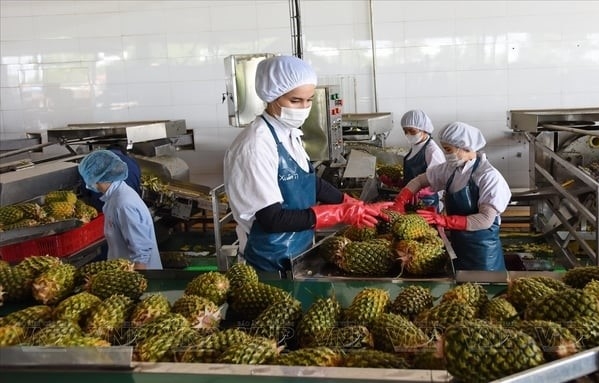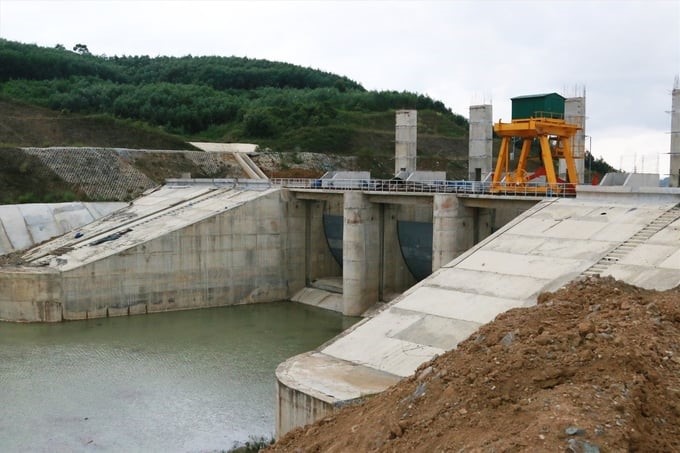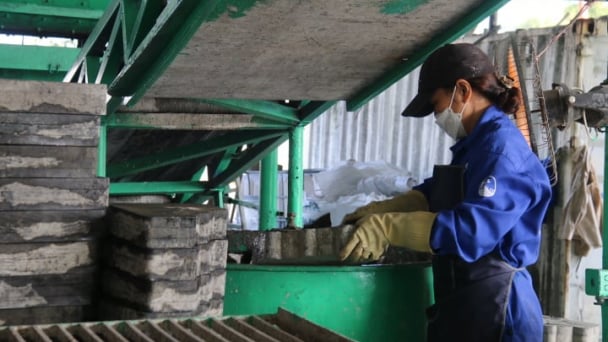May 18, 2025 | 17:52 GMT +7
May 18, 2025 | 17:52 GMT +7
Hotline: 0913.378.918
May 18, 2025 | 17:52 GMT +7
Hotline: 0913.378.918
Reporting on the results of the agricultural and rural sectors in the first 5 months of 2024, the Ministry of Agriculture and Rural Development (MARD) said that turnover in May 2024 reached USD 5.06 billion, an increase of 11.2% over the same period last year.
Overall, in the first 5 months, most commodity groups increased, so export turnover increased, reaching USD 24.14 billion. Of which, agricultural products reached USD 13.11 billion, up 27.7%; forest products reached USD 6.58 billion, up 22.7%; aquatic products reached USD 3.5 billion, up 3.6%; and livestock farming reached USD 199 million, up 5.6%.

Vegetables and fruits, aquatic products, and wood and wood products had stable export growth in the first half of 2024. Photo: VNA.
The key commodities all have positive signals. Specifically, wood and wood products reached an export turnover of USD 6.14 billion (up 23.6%); coffee of USD 2.9 billion (up 44.1%); rice of USD 2.65 billion (up 38.2%); cashew of USD 1.55 billion (up 19.3%); vegetables and fruits of USD 2.59 billion (up 28.1%); and shrimp of USD 1.3 billion (up 7.5%).
One of the impressive export commodity groups in the past 5 months has been wood and wood products. In May alone, this commodity group's turnover increased by 22.8% over the same period in 2023. MARD said that due to the recovery of consumer demand in major markets, it is expected that the export of wood and wood products will have positive growth and is likely to reach the set target of USD 17.5 billion in 2024.
The three largest export markets, including the US, China, and Japan, continue to be maintained, with export value to the US accounting for 20.6%; China for 19.2%; and Japan for 6.7%.
In addition, thanks to MARD's consistent and proactive direction in exploiting market signals, the average export price of many agricultural products increased. To be more specific, the price of rice is at USD 638/ton, an increase of 20.5%; coffee at USD 3,482/ton, up 49.9%; rubber at USD 1,504/ton, up 8.8%; and pepper at USD 4,308/ton, up 39.3%.
If from now until the end of the year there are no unusual developments in weather, natural disasters, or epidemics, rice, vegetable, and fruit production will ensure the set plan in terms of area, productivity, and output. Of which, the output of rice for export will reach about 7.6 million tons.
Regarding production results, MARD said that after 5 months, the whole country sowed 4.22 million hectares, down 1% compared to the same period last year, but the average productivity reached 6.76 tons/ha, an increase of 0.12 tons/ha. Output per harvested area reached 17.8 million tons, an increase of 2%.
Currently, MARD closely coordinates with localities, international organizations, and businesses to synchronously implement the "Sustainable Development Project of One Million Hectars specializing in high-quality and low-emission rice cultivation associated with green growth in the Mekong Delta until 2030."

MARD has a disbursement rate of public investment capital of 41%, among the top in the country. Photo: TL.
Forest fire prevention and control is focused, especially in key high-risk areas such as the Northwest, Central Highlands, and South. The damaged forest area in May was 204.9 hectares, down 42%, and the area accumulated in the first 5 months of the year was 652.3 hectares, down 27% over the same period last year.
MARD also directed and urged localities to implement the Secretariat's Directive No. 32-CT/TW dated April 10, 2024, and the Government's Action Program and Plan No. 52/NQ-CP dated April 22, 2024, on strengthening the Party's leadership in combating IUU fishing and promoting sustainable development of the fisheries sector.
The National Plan for the 2021–2030 period on protecting and exploiting aquatic resources has been approved by the Prime Minister.
MARD's disbursement rate of public investment capital is among the top in the country. MARD is allocated VND 9,935.3 billion in 2024. By the end of May 31, 2024, disbursement is estimated at VND 4,154.5 billion, reaching 41.8% of the plan.
Along with Vietnam Television, the Ministry of Construction, the Vietnam Bank for Social Policies, etc., MARD is among the group of ministries and central agencies with an estimated disbursement rate above the national average. Besides, there are some localities such as Tien Giang, Phu Tho, Tuyen Quang, and Hoa Binh.
Besides the bright spots, the agricultural and rural sectors still have problems with the number of communes meeting new rural standards, as this rate has not increased for many consecutive months since the beginning of 2024.
As of the end of May 2024, the whole country has 1,874 enhanced new rural communes (an increase of 14 communes compared to April 2024) and 347 model new rural communes (an increase of 7 communes). However, the number of new rural communes is 6,370/8,167 (78%), increasing by approximately 5% compared to the end of 2022 but not increasing compared to the end of December 2023.
The goal of the agriculture and rural sectors set for 2024 is to strive for 80% of communes to meet new rural standards. That means, in the last 7 months of the year, the whole country needs to have about 160 more communes meeting standards, equivalent to more than 20 communes/month.

Concrete road in a new rural commune in Dong Thap province. Photo: Le Hoang Vu.
In the immediate future, in June 2024, MARD will submit to the Prime Minister a policy to amend and supplement a number of regulations in Decision No. 321/QD-TTg dated March 8, 2022, on regulating provinces and cities completing the task of building new rural areas.
In addition to the problem of new rural areas, the work in the first 5 months of 2024 also has limitations on the number of agricultural cooperatives. According to the report, this number increased very slowly in quantity, especially in efficiency, which did not increase. Many cooperatives have not promoted their role as a connection between farmer households and businesses well.
Particularly, the number of businesses participating in linkage contracts to consume agricultural products is few in number and small in scale. The maintenance and sustainable development of value chain linkages are still limited.
At the Cooperative and Cooperative Economic Forum 2024, chaired by Prime Minister Pham Minh Chinh in early February 2024, the Cooperative Alliance reported that the growth rate of this area is only half of the general growth rate of the economy.
The proportion of the collective and cooperative economic sector in the country's GDP has been on a downward trend over the years. Specifically, this sector's contribution to GDP decreased from 8.06% in 2001 to 3.62% in 2020.
The level of cooperative management staff is not high. By 2023, the number of cooperative management staff with elementary and intermediate degrees only accounted for nearly 36% and with college and university degrees for only 23%.
Translated by Thu Huyen

(VAN) Deputy Minister Nguyen Quoc Tri also expressed his hope that Cuba will soon overcome its current challenges, attain food security, and further expand cooperation with Vietnam.

(VAN) The project contributes to enhancing the resilience of communities vulnerable to the impacts of climate change, with a primary focus on local women.

(VAN) Green materials help save energy and resources. However, after more than 10 years, Vietnam has only developed over 200 green buildings with more than 6 million square meters of floor space.

(VAN) Vietnam - Thailand Business Forum 2025: One plus one on three connects, marking a milestone in the comprehensive strategic partnership between the two nations.

(VAN) The United Nations designated 22 May as the International Day for Biodiversity 2025 with the theme 'Harmony with nature and sustainable development.'
![Multi-channel, multi-directional Vietnamese agricultural markets: [8] A national strategy is needed](https://t.ex-cdn.com/nongnghiepmoitruong.vn/608w/files/phucpm/2025/05/15/1435-thi-truong-nong-san-viet-da-kenh-da-huongbai-8-can-mot-chien-luoc-quoc-gia-084750_728.jpg)
(VAN) The Chairman of Hung Nhon Group shared: ‘Opening up and tapping into new markets is the right and strategic direction for Vietnam's agricultural sector.’

(VAN) Food waste has become a serious issue in modern society, especially in rapidly urbanizing and developing cities like Hanoi.